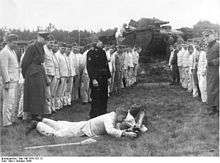Grosstraktor
Grosstraktor (German: "large tractor") was the codename given to six prototype medium tanks built (two each) by Rheinmetall-Borsig (Grosstraktor II), Krupp and Daimler (Grosstraktor I), for the Weimar Republic, in violation of the Treaty of Versailles. Constructed in secret, they were tested by Reichswehr units at the Kama tank school in the Soviet Union. They were used for training and retired as monuments after the Nazi party came to power.[1]
| Grosstraktor (Großtractor) | |
|---|---|
 The Grosstraktor used for anti-tank training | |
| Type | Medium tank |
| Place of origin | Weimar Republic |
| Service history | |
| In service | 1935 |
| Used by | Weimar Republic Nazi Germany |
| Production history | |
| Designed | 1926 |
| Manufacturer | Rheinmetall, Krupp, Daimler |
| Produced | 1928–1930 |
| No. built | 6 |
| Specifications | |
| Mass | 19 tonnes (21 short tons) |
| Length | 6.6 m (21 ft 8 in) |
| Width | 2.81 m (9 ft 3 in) |
| Height | 2.3 m (7 ft 7 in) |
| Crew | 6 |
| Armor | 13 mm mild steel |
Main armament | One 75 mm KwK L 24 |
| Engine | BMW Va 6-cylinder 250 PS |
| Suspension | coil-spring suspension (Rheinmetall, Krupp) leaf springs suspension (Daimler-Benz) |
Operational range | 150 km (93 mi) on-road |
| Maximum speed | 40 km/h (25 mph) on-road |
Development
In 1926 various German companies, including Rheinmetall and Daimler-Benz, each produced a single prototype Großtraktor ("large tractor", so codenamed to veil the true purpose of the vehicle) armed with a large 75-millimeter cannon.[2] Development of the subsequent Neubaufahrzeug (German for "new construction vehicle") started in 1933 when the then Reichswehr gave a contract for the development of a follow-on Großtraktor to both Rheinmetall and Krupp.
References
- Peter Chamberlin and Hillary Doyle, Encyclopedia of German Tanks of World War Two, 1978, 1999, p. 147
- Franco, Panzer I: El Inicio de una Saga, p.3